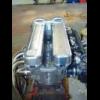I believe this is one for Dan, or for anyone here who has experienced this.
I run a 1275 A series engine in an Austin Healey Sprite. Engine is circa 1968. Although inline and not transverse it's not so different. The crankcase breather system differs in that it only has one breather cannister, at the front, on the timing cover. Otherwise it connects to the twin SUs via a Y piece the same way as on a classic Mini. The other difference of course, is that mine doesn't share the engine oil with the g/box
The engine spec.
1275 +30 19320 pistons. 1300GT head. Standard Cam. Twin HS2, KandN air filters. Long centre branch exhaust manifold. Plastic mesh vented oil filler cap. 20/50 mineral oil. Oil pressure on cold start 80+, hot 40/50+. Circa 20000 miles on engine since last rebuild. One of many in it's life.
Breather system.
Pipe from the timing cover breather cannister, via a Y piece to the individual connections on the carbs. Plastic wire mesh filled oil filler cap, on the otherwise sealed rocker cover.
Engine condition
No excess blowby, the compression is good. No oil being forced out of the front crankcase oil seal, or the oil scroll on the rear, or from the sump gaskets.
Here's what happens.
After starting the engine, --- from dead cold or almost dead cold, on cold days, mostly in the winter or early spring, after driving about 2-3 miles, or in other words just as the engine is warming through, when on the over run, and the vacuum is high, a column of liquid oil is sucked under vacuum from the timing cover, and into the engine.
This results in a thick cloud of blue smoke as the engine tries to burn off the oil injected into the combustion chambers.
If the revs are allowed to die down to tickover, or of course the engine switched off, the oil sucking stops. If the engine is allowed to rest no more than a few mins or even less, when driving on again, the sucking of oil is not repeated, until the next start from dead or near to dead cold.
I emphasise a column of liquid oil. Not oil mist or vapour, and not a few drops. The entire breather pipe is filled with an unbroken column of liquid oil. So much so that it drips from the exhaust tail pipe if allowed to continue doing this.
I have fitted a clear plastic pipe to the breather cannister and observed this happening, on numerous occasions.
Note: This does not happen on warm or hot days, when the only difference is that the oil is warmer, and hence thinner. It doesn't happen, when starting from hot.
For this to be possible the timing cover has to fill with oil to the level of the internal entrance to the breather cannister. As it only does this when cold, and then ceases once warm, it is clear the oil level in the timing cover must reduce as the engine warms through.
I understand that oil is injected into the timing cover, under reduced pressure, via the front camshaft journal/bearing, through the small hole in the camshaft locating endplate, which is mounted to the front of the engine front plate. My conclusion is that too much oil is being delivered, whilst at the same time, it can't drain back into the sump fast enough.
Stripping the engine revealed, that the 2 drain holes in the front main cap were clear, as was the large hole in the engine plate, more or less adjacent to the camshaft hole.
If the drains are clear, and the large hole that could act as an over flow, does not prevent this, then the oil must be entering the timing cover faster than either the drains or "overflow" can remove it.
When the oil thins sufficiently, and presumably the oil pressure is therefore also reduced, the 2 drain holes catch up, and the oil delivery slows, allowing the oil level to subside below the level of the breather cannister entrance, and the oil ceases to be drawn by vacuum suction into the induction system.
There is no mistake about what is happening, and I am fairly certain -- ish--, why. It is my thinking that too much oil is continuosly escaping past/under the camshaft endplate, and not only passing through the oil feed hole that it should pass through, once per revolution of the camshaft.
As there were far more A series engines installed in Minis, than were ever installed in Sprites and Midgets, I'm hoping that someone here will have heard of this, and know the "exact" cause, and hence solution. Naturally I have asked in the Spridget world, and in fact I've been aware of this problem for over 25 years. I have yet to find someone else who also has experience of it, until very recently, and this has prompted me to seek others in order to gain a better understanding. So far I seem to be the only one with answers to this, and I just can't believe that after 50 plus or more years of the A series engine, I'm the only one who has heard of this.
Has anyone here experienced this before, or heard of it? If so your input would be greatly appreciated.
Thanks.
















